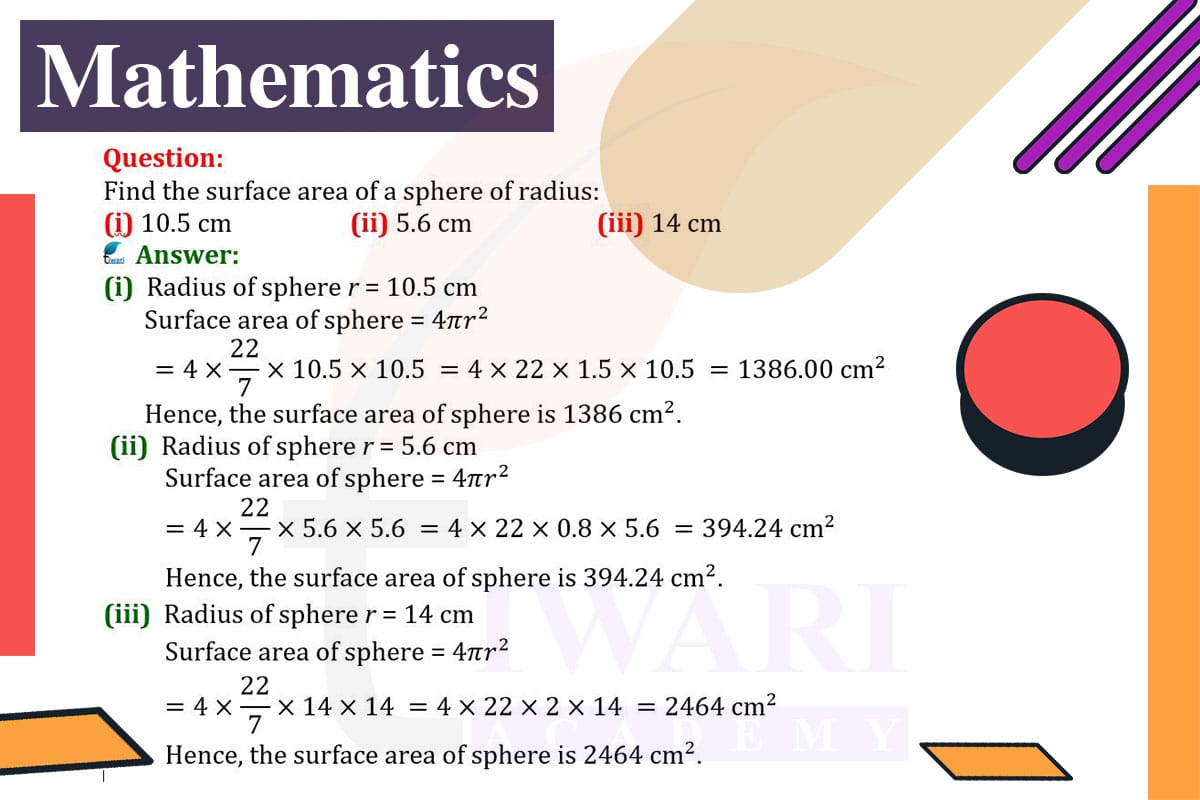The surface area of a sphere is given by the formula 4πr².
(i) For a radius of 10.5 cm, the surface area is 4 × 3.14 × 10.5² ≈ 1385.46 cm².
(ii) For a radius of 5.6 cm, it’s 4 × 3.14 × 5.6² ≈ 394.24 cm².
(iii) For a radius of 14 cm, the area is 4 × 3.14 × 14² ≈ 2463.04 cm².

Let’s discuss in detail
Introduction to Sphere Surface Area Calculation
Calculating the surface area of a sphere is a fundamental concept in geometry, essential in various fields such as physics, engineering, and design. The surface area determines the amount of material needed for making spherical objects or the amount of paint required to cover them. In this task, we calculate the surface area of spheres with different radii: 10.5 cm, 5.6 cm, and 14 cm. The formula used for these calculations is 4πr², where r is the radius of the sphere.
Surface Area of a Sphere with Radius 10.5 cm
For a sphere with a radius of 10.5 cm, the surface area calculation involves squaring the radius and then multiplying by 4π. Squaring 10.5 cm gives 110.25 cm². Multiplying this by 4π (approximately 3.14) gives the total surface area. The calculation is 4 × 3.14 × 110.25, which equals approximately 1385.46 cm². This surface area is indicative of the total external coverage of the sphere.
Surface Area of a Sphere with Radius 5.6 cm
In the case of a sphere with a radius of 5.6 cm, the same formula is applied. Squaring the radius (5.6 cm) yields 31.36 cm². Multiplying this by 4π gives the surface area. The calculation is 4 × 3.14 × 31.36, resulting in approximately 394.24 cm². This smaller surface area reflects the proportionally smaller size of this sphere compared to the first.
Surface Area of a Sphere with Radius 14 cm
For a larger sphere with a radius of 14 cm, the surface area is calculated similarly. Squaring the radius (14 cm) gives 196 cm². This value is then multiplied by 4π to find the surface area. The calculation is 4 × 3.14 × 196, which equals approximately 2463.04 cm². This is the largest surface area among the three spheres, correlating with its larger radius.
Comparative Analysis of Surface Areas
Comparing the surface areas of these spheres highlights how the surface area increases significantly with the radius. The sphere with the smallest radius (5.6 cm) has the smallest surface area, while the largest sphere (14 cm in radius) has the greatest surface area. This relationship is quadratic, as the surface area is proportional to the square of the radius, demonstrating a fundamental property of spherical geometry.
Conclusion and Practical Implications
These calculations illustrate the practical importance of understanding geometric principles, particularly in scenarios requiring material estimation or coverage calculation. The surface area of spheres, as determined by their radii, plays a crucial role in various applications, from manufacturing to scientific research. This exercise underscores the relevance and application of geometry in solving real-world problems and in the understanding of spatial properties of common shapes.
Discuss this question in detail or visit to Class 9 Maths Chapter 11 for all questions.
Questions of 9th Maths Exercise 11.2 in Detail

